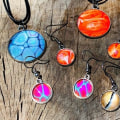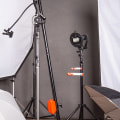Photographers need to know the basics of studio space and backgrounds when it comes to product photography. Without the right knowledge and equipment, capturing professional-looking photographs can be difficult. This article will provide photographers with the information they need to understand the importance of studio space and backgrounds, as well as the best equipment and techniques to use. When it comes to product photography, the right studio space and background can make all the difference. A studio with a good selection of backgrounds and props, such as 3 Point Slingers for Cameras, can help photographers create stunning images that stand out from the rest. The right setup also ensures that the product being photographed looks its best and is presented in the most flattering way.
With this in mind, it's important for photographers to understand the basics of studio space and backgrounds. In this article, we'll discuss the importance of studio space and backgrounds for product photography, as well as the best equipment and techniques to use. We'll also provide helpful tips for setting up your own studio space and creating the perfect background for your product shots.
Choosing the Right Studio Space and Backgrounds
When selecting a studio space and background for product photography, there are several factors to consider. It's important to find a space that is large enough to accommodate the product you are photographing, while also providing adequate lighting and plenty of backdrop options. The type of space you choose will depend on the type of product you are shooting, as well as the look you are trying to achieve.Studio spaces range from small home studios to large professional studios. Home studios are often limited in size and can be more difficult to light properly, but they offer a more personal feel. Professional studios are often larger and more expensive, but they can provide a more professional look with better lighting and more backdrop options. When it comes to backgrounds, there are a variety of options available depending on the look you are trying to achieve.
Solid colored backdrops such as white or black are great for creating a clean, minimal look. Textured or patterned backdrops can add visual interest and depth to an image. You can also use props or everyday items to create a more natural look. No matter what type of studio space and background you choose, it's important to make sure that it fits your budget, is well-lit, and can provide the look you are going for.
With careful planning and consideration of your product and desired outcome, you can create beautiful product photographs in any space.
Setting Up the Studio Space and Backgrounds
Studio Space and Backgrounds:When it comes to setting up a studio space and backgrounds for product photography, there are several factors to consider. Equipment setup, lighting, and background selection are all important components of the process. Here we’ll explain everything you need to know about setting up the perfect studio space and background. The first step is to select the right equipment. If you’re a professional photographer, you may already have much of the necessary equipment.If you’re an amateur just starting out, there are many affordable options available. Depending on the type of photography you’re doing, you may need a camera, tripod, reflectors, light stands, and flashes or strobes. You may also want to invest in additional equipment, such as diffusers and gels. Once you’ve chosen your equipment, it’s time to set up the studio space. You’ll want to choose a space that is large enough to accommodate all of your equipment, and that has good natural light.
When selecting a background, it should be a neutral color and not too busy. A white or light gray background is typically ideal. Lighting is also an important component of product photography. You can use natural light or artificial light sources. If you’re using artificial light sources, you’ll want to make sure that you have the right lighting setup.
This includes positioning your lights in the right places and at the right angles. Additionally, you may want to use reflectors or diffusers to create softer lighting. Finally, it’s important to remember that product photography is all about creating the perfect image. So take your time setting up the studio space and backgrounds to ensure that you get the best results possible.




Leave Message